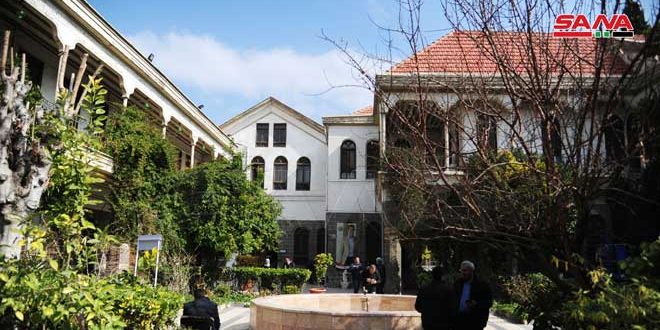The old Damascene house is famous for its unique architecture, characteristic and style. One of the most prominent features of these houses is the central open courtyard with a water fountain in the center along with trees and plants surrounding the space where the family and guests can sit and enjoy the atmosphere of old Shami lifestyle. Some old houses have paintings decorating the walls. You can also find Islamic calligraphy decorating the ceilings.
Maktab Anbar , which is a house in the center of Old Damascus near Ummayyad Mosque, is considered the second largest house in Damascus, in which unique decorations and inscription spread over a large area .
Maktab Anbar was not only a beautiful Damascene house, but after its inauguration 150 years ago, it turned into a school from which the most prominent national and cultural figures graduated, including the poet Khalil Mardam Beik , the writer of the Syrian Arab anthem, Badawi al-Jabal, the famous poet Nizar Qabbani, the former President Shukri al-Quwatli, and others who had important achievements in the Syrian history.
“This building is considered one of the most perfect Damascene houses in terms of area and architectural design after Al-Azm Palace” Director of the Old Damascus Directorate, Eng. Mazen Farzali said in a statement to SANA.
He indicated that it is divided into three parts: the first is for men, the second is for women, while the third is for the servants.
Eng. Farzali He pointed out that Maktab Anbar was never used as a house, as the Ottoman occupation authorities seized it from its first owner, Youssef Anbar, due to the accumulation of his debts .
 He added It was called “ Maktab” which means a place for writing, and was adopted as a school for different teaching stages from the last third of the 19th century until the seventies, when work in it as an educational facility stopped to be called later , with the advent of the eighties, as “the Culture Palace” , and it was adopted as the headquarters of Old Damascus.
He added It was called “ Maktab” which means a place for writing, and was adopted as a school for different teaching stages from the last third of the 19th century until the seventies, when work in it as an educational facility stopped to be called later , with the advent of the eighties, as “the Culture Palace” , and it was adopted as the headquarters of Old Damascus.“ The area of Maktab Anbar is 4000 square meters ansd it is the large area that is not attributed to a house. Therefore, it is considered the second palace after Al-Azam Palace and there are also such palaces in some neighborhoods of old Damascus” according to Farzali.
Farzali referred that it is distinguished by its different kinds of decoration to embody a bright intermixing of Arab and European cultures in the construction process.
Farzali made it clear that Maktab Anbar is one of the first schools in Damascus and has several open courtyards in its initial design which were used for students , in addition to containing 40 rooms that were used by the school , pointing out that some Damascene houses are still used as schools.
“Currently , the basic shape of the building has been preserved in terms of spaces, open courtyards and decoration. Some sections of Maktab Anbar are employed to be the headquarters of the Old Damascus Directorate to provide services to citizens” according to Farzali.
Rawaa Ghanam

